Cotingidae – Cotingas, Fruiteaters & Allies
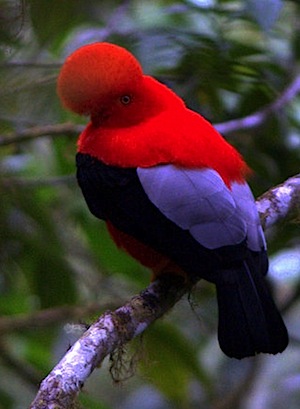
Cotingidae are a family of Passeriformes sitting between the Pipridae (Manakins) and the Tityridae (Tityras & Becards). They are a large family of passerine bird species found in Central America and tropical South America. They live in deserts, open woodlands, coastal mangroves, and humid tropical forests. Cotingas face very serious threats from loss of their habitats.
A 2014 molecular phylogenetic study of the cotingas by Jacob Berv and Richard Prum found that the genera formed five monophyletic clades and they proposed that the family could be divided into five subfamilies. They would be Pipreolinae encompassing the Ampeliopides and Pipreola genera; Rupicolinae encompassing four genera – Snowornis, Carpornis, Phoenicircus & Rupicola; Phytotominae for another five genera – Zaratornis, Phytotoma, Phibalura, Doliornis & Ampelion; Cephalopterinae encompassing Haematoderus, Querula, Pyrodelus, Perissocephalus & Cephalopterus and, lastly, Cotinginae for the rest: Lipaugus, Procnias, Cotinga, Porphyrolaema, Conioptilon, Gymnoderus, Xipholena & Carpodectes.

Chestnut-crested Cotinga Ampelion rufaxilla – ©Dubi Shapiro
They are generally birds of forests or forest edges, and mostly eat fruit or insects & fruit. Comparatively little is known about this diverse group, although all have broad bills with hooked tips, rounded wings, and strong legs. 66 species in 24 genera, they may be the most diverse passerine family in body size, ranging from 8 centimetres to the world’s largest suboscine in the 50 centimetres male Amazonian Umbrellabird.
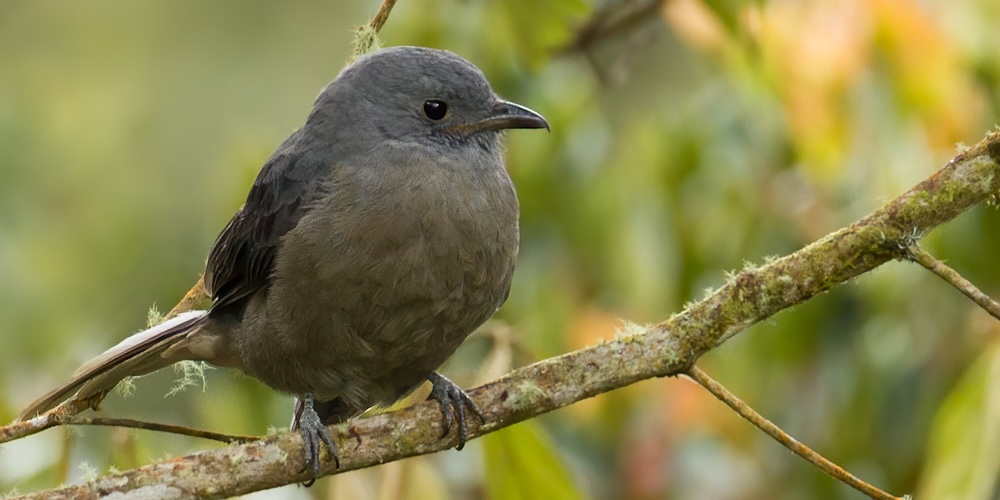
Dusky Piha Lipaugus fuscocinereus – ©Dubi Shapiro
They inhabit a variety of forested ecosystems, including the dense understory of humid tropical rainforests, open woodlands, coastal mangroves, and the edges of forests where they can be more easily observed. They are primarily frugivorous, feeding on a wide range of fruits, which makes them vital for the dispersal of seeds and the propagation of forest plants. Some species, such as the plantcutters, have evolved to consume leaves and flowers, a rare diet among birds. Larger cotingas occasionally supplement their fruit diet with invertebrates, thus contributing to the control of insect populations.
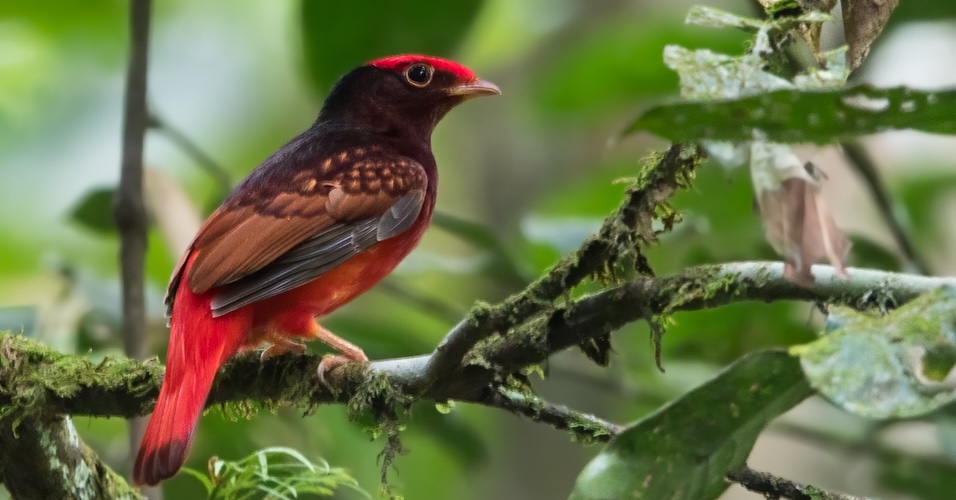
Guianan Red Cotinga Phoenicircus carnifex – ©Dubi Shapiro
Cotingas exhibit a dazzling array of colorations, from the deep blues and vibrant reds of the males to the more camouflaged greens and browns of the females. This sexual dimorphism is often pronounced, with males displaying vivid colours and elaborate feathers to attract mates. The diversity in their calls is equally impressive, from the haunting whistles of the Screaming Piha to the metallic sounds of the Bellbirds.
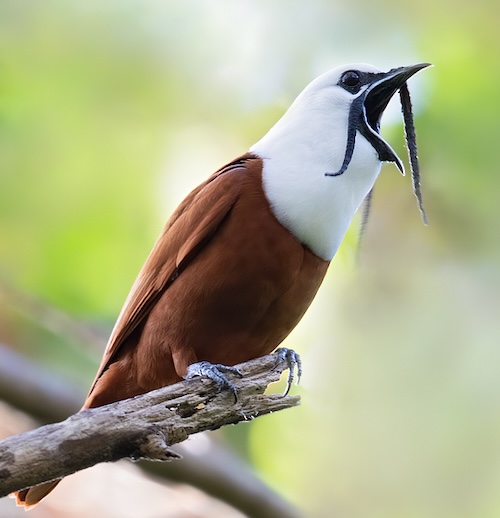
Three-wattled Bellbird Procnias tricarunculatus – ©Dubi Shapiro
Cotingas vary widely in social structure. There is a roughly 50/50 divide in the family between species with biparental care, and those in which the males play no part in raising the young. For example, the Purple-throated Fruitcrow lives in mixed-sex groups in which one female lays an egg and the others help provide insects to the chick.
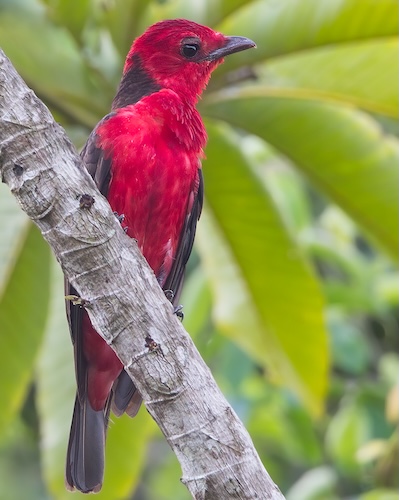
Crimson Fruitcrow Haematoderus militaris – ©Dubi Shapiro
In cotinga species where only the females care for the eggs and young, the males have striking courtship displays, often grouped together in leks. Such sexual selection results in the males of these species, including the Guianan Cock-of-the-rock, being brightly coloured, or decorated with plumes or wattles, like the umbrellabirds, with their umbrella-like crest and long throat wattles.
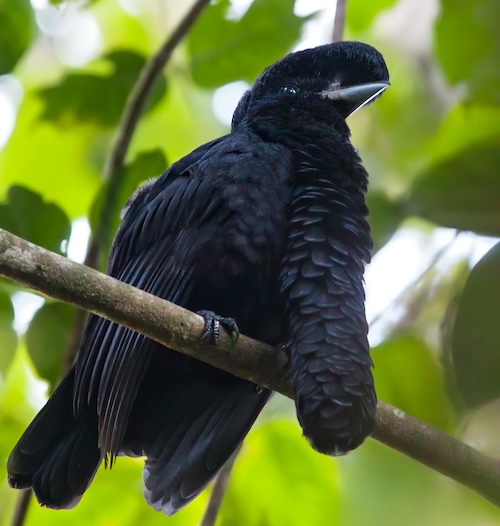
Long-wattled Umbrellabird Cephalopterus penduliger – ©Dubi Shapiro
Other lekking cotingids like the bellbirds, have distinctive and far-carrying calls.
In such canopy-dwelling genera as Carpodectes, Cotinga, and Xipholena, males gather high in a single tree or in adjacent trees, but male cocks-of-the-rock, as befits their more terrestrial lives, give their elaborate displays in leks on the ground. The females of both lekking and bi-parental species are duller than the males.
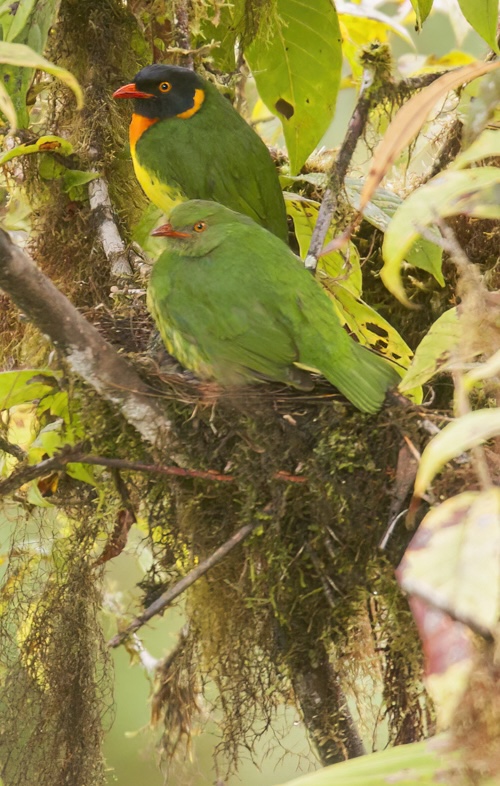
Orange-breasted Fruiteater Pipreola jucunda – ©Dubi Shapiro
Nests range from tiny to very large. Many species lay a single egg in a nest so flimsy that the egg can be seen from underneath. This may make the nests hard for predators to find. Fruiteaters build more solid cup nests, and the cocks-of-the-rock attach their mud nests to cliffs.
The nests may be open cups or little platforms with loosely woven plant material, usually placed in a tree.
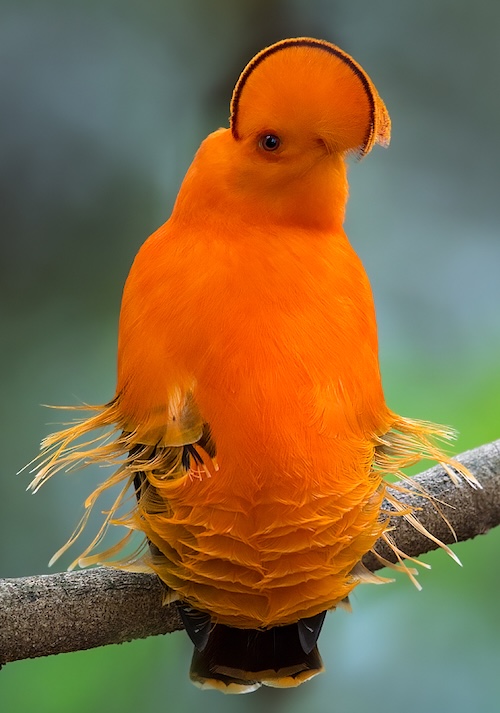
Guianan Cock-of-the-rock Rupicola rupicola – ©Dubi Shapiro
The clutches comprise one to four eggs. Incubation typically takes fifteen to twenty-eight days. Fledging usually occurs at 28-33 days.
-
Number of bird species: 66
(As at July 2025)
After recent revision of the family Cotingidae following DNA sequencing, most authorities agree that there are 66 (or 25 pending further investigation of Palkachupa Cotinga) species in 24 genera in this family; they are:
Scaled Fruiteater Ampelioides tschudii
Green-and-black Fruiteater Pipreola riefferii
Band-tailed Fruiteater Pipreola intermedia
Barred Fruiteater Pipreola arcuata
Golden-breasted Fruiteater Pipreola aureopectus
Orange-breasted Fruiteater Pipreola jucunda
Black-chested Fruiteater Pipreola lubomirskii
Masked Fruiteater Pipreola pulchra
Scarlet-breasted Fruiteater Pipreola frontalis
Fiery-throated Fruiteater Pipreola chlorolepidota
Handsome Fruiteater Pipreola formosa
Red-banded Fruiteater Pipreola whitelyi
Black-headed Berryeater Carpornis melanocephala
Hooded Berryeater Carpornis cucullata
Grey-tailed Piha Snowornis subalaris
Olivaceous Piha Snowornis cryptolophus
Guianan Red Cotinga Phoenicircus carnifex
Black-necked Red Cotinga Phoenicircus nigricollis
Guianan Cock-of-the-rock Rupicola rupicola
Andean Cock-of-the-rock Rupicola peruvianus
White-cheeked Cotinga Zaratornis stresemanni
Swallow-tailed Cotinga Phibalura flavirostris
Palkachupa Cotinga Phibalura (flavirostris) boliviana
Peruvian Plantcutter Phytotoma raimondii
White-tipped Plantcutter Phytotoma rutila
Rufous-tailed Plantcutter Phytotoma rara
Bay-vented Cotinga Doliornis sclateri
Chestnut-bellied Cotinga Doliornis remseni
Red-crested Cotinga Ampelion rubrocristatus
Chestnut-crested Cotinga Ampelion rufaxilla
Crimson Fruitcrow Haematoderus militaris
Purple-throated Fruitcrow Querula purpurata
Red-ruffed Fruitcrow Pyroderus scutatus
Capuchinbird Perissocephalus tricolor
Bare-necked Umbrellabird Cephalopterus glabricollis
Amazonian Umbrellabird Cephalopterus ornatus
Long-wattled Umbrellabird Cephalopterus penduliger
Purple-throated Cotinga Porphyrolaema porphyrolaema
Bare-necked Fruitcrow Gymnoderus foetidus
Black-faced Cotinga Conioptilon mcilhennyi
Pompadour Cotinga Xipholena punicea
White-tailed Cotinga Xipholena lamellipennis
White-winged Cotinga Xipholena atropurpurea
Black-tipped Cotinga Carpodectes hopkei
Yellow-billed Cotinga Carpodectes antoniae
Snowy Cotinga Carpodectes nitidus
Lovely Cotinga Cotinga amabilis
Turquoise Cotinga Cotinga ridgwayi
Blue Cotinga Cotinga nattererii
Plum-throated Cotinga Cotinga maynana
Purple-breasted Cotinga Cotinga cotinga
Banded Cotinga Cotinga maculata
Spangled Cotinga Cotinga cayana
Three-wattled Bellbird Procnias tricarunculatus
White Bellbird Procnias albus
Bearded Bellbird Procnias averano
Bare-throated Bellbird Procnias nudicollis
Rufous Piha Lipaugus unirufus
Rose-collared Piha Lipaugus streptophorus
Screaming Piha Lipaugus vociferans
Cinnamon-vented Piha Lipaugus lanioides
Black-and-gold Cotinga Lipaugus ater
Grey-winged Cotinga Lipaugus conditus
Chestnut-capped Piha Lipaugus weberi
Dusky Piha Lipaugus fuscocinereus
Scimitar-winged Piha Lipaugus uropygialis
-
Cotinga
WebsiteThis is the journal of the Neo-tropical Bird Club
-
Cotingidae
Family AccountCotingas are birds that are exclusive to the tropical forests of Central and South America. This family is celebrated for its incredible diversity, with species ranging from the small and unassuming to the large and flamboyant, each with unique ecological roles and behaviors. -
Cotingidae
Family AccountThe cotingas are a large family, Cotingidae, of suboscine passerine birds found in Central America and tropical South America. Cotingas are birds of forests...
Given the number of species in this family, Fatbirder does not provide quick links to all of them. However, the entries below do include links to representatives of every genera and some of the most often encountered or sought-after species.
-
Bare-necked Fruitcrow Gymnoderus foetidus
Species AccountUnusual medium-sized bird of forest canopy in Amazonia. Dark blue overall with bare, wrinkly blue skin on the neck and a pale bill. -
Bare-necked Fruitcrow Gymnoderus foetidus
Species AccountThe bare-necked fruitcrow (Gymnoderus foetidus) is a species of bird in the family Cotingidae. It is the only member of the genus Gymnoderus. -
Bare-necked Fruitcrow Gymnoderus foetidus
Species AccountSound archive and distribution map -
Bay-vented Cotinga Doliornis sclateri
Species AccountUncommon cotinga found only in very high-elevation forest near treeline in the eastern Andes of central Peru. Adult plumage is gray with a tan breast and belly -
Bay-vented Cotinga Doliornis sclateri
Species AccountThe bay-vented cotinga (Doliornis sclateri) is a species of bird in the family Cotingidae. It is endemic to Peru. ... Its natural habitats are subtropical or... -
Bay-vented Cotinga Doliornis sclateri
Species AccountSound archive and distribution map -
Black-faced Cotinga Conioptilon mcilhennyi
Species AccountA distinctively plumaged, vocal cotinga. Light gray, with darker gray wings and a black face. Occurs in a variety of forested habitats, preferring swampy... -
Black-faced Cotinga Conioptilon mcilhennyi
Species AccountThe black-faced cotinga (Conioptilon mcilhennyi) is a species of bird in the family Cotingidae. It is the only member of the genus Conioptilon. -
Black-faced Cotinga Conioptilon mcilhennyi
Species AccountSound archive and distribution map -
Blue Cotinga Cotinga nattererii
Species AccountThe blue cotinga (Cotinga nattererii) is a species of bird in the family Cotingidae. It is found in Colombia, north-west Ecuador, eastern and central Panama and western Venezuela in tropical moist lowland forests and heavily degraded former forest. -
Blue Cotinga Cotinga nattererii
Species AccountSound archive and distribution map -
Capuchinbird Perissocephalus tricolor
Species AccountLarge, bizarre bird of tall rainforest. Unmistakable even when seen briefly, as they often are, flying quickly across roads or rivers. -
Capuchinbird Perissocephalus tricolor
Species AccountThe capuchinbird or calfbird (Perissocephalus tricolor) is a large passerine bird of the family Cotingidae. It is monotypic within the genus Perissocephalus. -
Capuchinbird Perissocephalus tricolor
Species AccountSound archive and distribution map -
Chestnut-crested Cotinga Ampelion rufaxilla
Species AccountKey features include its mostly orange throat and neck and bold dark streaks on a pale yellowish belly. Also note the red eye and small chestnut shoulder patch. -
Chestnut-crested Cotinga Ampelion rufaxilla
Species AccountThe chestnut-crested cotinga (Ampelion rufaxilla) is a species of bird in the family Cotingidae. It is found in the northern Andes of Bolivia, Colombia... -
Chestnut-crested Cotinga Ampelion rufaxilla
Species AccountSound archive and distribution map -
Crimson Fruitcrow Haematoderus militaris
Species AccountSound archive and distribution map -
Crimson Fruitcrow Haematoderus militaris
Species AccountCrimson Fruitcrow Haematoderus militaris Usually seen perched high in bare branches. Feeds on fruit that it plucks in short sallies, like a giant manakin. -
Crimson Fruitcrow Haematoderus militaris
Species AccountThe crimson fruitcrow (Haematoderus militaris) is a species of bird in the large family Cotingidae, not a crow. The only member of the genus Haematoderus -
Dusky Piha Lipaugus fuscocinereus
Species AccountThis large, relatively long-tailed cotinga is completely lacking in distinctive plumage: it is entirely plain gray. Sexes alike. -
Dusky Piha Lipaugus fuscocinereus
Species AccountThe dusky piha (Lipaugus fuscocinereus) is a species of bird in the family Cotingidae. ... It is found in Colombia, Ecuador, and Peru. -
Dusky Piha Lipaugus fuscocinereus
Species AccountSound archive and distribution map -
Grey-tailed Piha Snowornis subalaris
Species AccountOlive with a blotchy white eyering and gray belly and tail. Black crown stripe is usually concealed. It feeds on both fruit and insects inside tall forest -
Grey-tailed Piha Snowornis subalaris
Species AccountThe grey-tailed piha (Snowornis subalaris) is a species of bird in the family Cotingidae. It is found in Colombia, Ecuador and Peru where its natural habitat... -
Grey-tailed Piha Snowornis subalaris
Species AccountSound archive and distribution map -
Guianan Cock-of-the-rock Rupicola rupicola
Species AccountA large, chunky cotinga, always preceded by its reputation. Exquisite adult male is impossible to mistake for anything else. -
Guianan Cock-of-the-rock Rupicola rupicola
Species AccountThe Guianan cock-of-the-rock (Rupicola rupicola) is a species of cotinga, a passerine bird from South America. It is about 30 cm (12 in) in length. -
Guianan Cock-of-the-rock Rupicola rupicola
Species AccountSound archive and distribution map -
Guianan Red Cotinga Phoenicircus carnifex
Species AccountHandsome but seldom-seen cotinga of lowland rainforest. Males are brilliant red and dark rich brown; females are duller but identifiable by red and brown... -
Guianan Red Cotinga Phoenicircus carnifex
Species AccountThe Guianan red cotinga (Phoenicircus carnifex) is a species of bird in the family Cotingidae, the cotingas. It is one of two species in the genus Phoenicircus. -
Guianan Red Cotinga Phoenicircus carnifex
Species AccountSound archive and distribution map -
Hooded Berryeater Carpornis cucullata
Species AccountBig and chunky rainforest cotinga with a long tail. Found in the canopy of montane forests where it can be locally common, but hard to see. -
Hooded Berryeater Carpornis cucullata
Species AccountThe hooded berryeater (Carpornis cucullata) is a species of bird in the family Cotingidae. It is endemic to Brazil. -
Hooded Berryeater Carpornis cucullata
Species AccountSound archive and distribution map -
Long-wattled Umbrellabird Cephalopterus penduliger
Species AccountSound archive and distribution map -
Long-wattled Umbrellabird Cephalopterus penduliger
Species AccountSpectacular crow-like bird with a bushy crest. Male has a thick feathered wattle dangling from his throat that can be extended to an astonishing length... -
Long-wattled Umbrellabird Cephalopterus penduliger
Species AccountThe long-wattled umbrellabird (Cephalopterus penduliger) is an umbrellabird in the Cotingidae family. -
Peruvian Plantcutter Phytotoma raimondii
Species AccountScarce cotinga restricted to dry lowland forest in northwestern Peru. Male is gray with a reddish belly and forehead and white wingbars. -
Peruvian Plantcutter Phytotoma raimondii
Species AccountThe Peruvian plantcutter (Phytotoma raimondii) is an endangered species of bird in the family Cotingidae. As the other plantcutters, this species is sexually... -
Peruvian Plantcutter Phytotoma raimondii
Species AccountSound archive and distribution map -
Pompadour Cotinga Xipholena punicea
Species AccountThis species has an extremely large range, and hence does not approach the thresholds for Vulnerable under the range size criterion -
Pompadour Cotinga Xipholena punicea
Species AccountSound archive and distribution map -
Pompadour Cotinga Xipholena punicea
Species AccountThe pompadour cotinga (Xipholena punicea) is a species of bird in the family Cotingidae, the cotingas. -
Purple-breasted Cotinga Cotinga cotinga
Cornell Species AccountThe color of the upperparts in the male Purple-breasted Cotinga is a deep blue, rather than the pale turquoise-blue of the rather larger male Spangled Cotinga (Cotinga cayana), which species is the only broadly sympatric congener. -
Purple-breasted Cotinga Cotinga cotinga
Species AccountSound archive and distribution map -
Purple-breasted Cotinga Cotinga cotinga
Species AccountThe purple-breasted cotinga (Cotinga cotinga) is a species of bird in the family Cotingidae. It is found in Brazil, Colombia, French Guiana, Guyana, Peru, Suriname, and Venezuela. Its natural habitat is subtropical or tropical moist lowland forests. -
Purple-throated Fruitcrow Querula purpurata
Species AccountLarge, mostly black bird found in the canopy of lowland forests. Male has wine-colored throat that can be puffed out expressively, but is often difficult to... -
Purple-throated Fruitcrow Querula purpurata
Species AccountThe purple-throated fruitcrow (Querula purpurata) is a species of bird in the family Cotingidae, the cotingas. It is the only species of the genus Querula. -
Purple-throated Fruitcrow Querula purpurata
Species AccountSound archive and distribution map -
Red-ruffed Fruitcrow Pyroderus scutatus
Species AccountHuge spectacular black-and-red cotinga with a strong, heavy bill. Glossy-black above with a bright red throat and breast, the extent of which varies between... -
Red-ruffed Fruitcrow Pyroderus scutatus
Species AccountThe red-ruffed fruitcrow (Pyroderus scutatus) is a species of bird in the monotypic genus Pyroderus. It belongs to the family Cotingidae. -
Red-ruffed Fruitcrow Pyroderus scutatus
Species AccountSound archive and distribution map -
Scaled Fruiteater Ampelioides tschudii
Species AccountSound archive and distribution map -
Scaled Fruiteater Ampelioides tschudii
Species AccountThe scaled fruiteater (Ampelioides tschudii) is a species of bird in the family Cotingidae. It is the only member of the genus Ampelioides. -
Scaled Fruiteater Ampelioides tschudii
Species AccountChunky, short-tailed, flat-headed bird patterned in mossy green and black. Scaly above and below with broad green wingbar and black cap. -
Scarlet-breasted Fruiteater Pipreola frontalis
Species AccountPlump, colorful bird of cloud forest along the east slope of the Andes. Plumage is mostly green and yellow, and male has a red throat and breast. -
Scarlet-breasted Fruiteater Pipreola frontalis
Species AccountThe scarlet-breasted fruiteater (Pipreola frontalis) is a species of bird in the family Cotingidae. It is found in Bolivia, Ecuador, and Peru. -
Scarlet-breasted Fruiteater Pipreola frontalis
Species AccountSound archive and distribution map -
Snowy Cotinga Carpodectes nitidus
Species AccountMale is entirely snowy white with stout dark bill. Female also has stout gray bill, but body entirely pale gray with obvious white edges on wing feathers. -
Snowy Cotinga Carpodectes nitidus
Species AccountThe snowy cotinga (Carpodectes nitidus) is a medium-sized species of passerine bird in the family Cotingidae. It is found in Central America. -
Snowy Cotinga Carpodectes nitidus
Species AccountSound archive and distribution map -
Spangled Cotinga Cotinga cayana
Species AccountThis species has an extremely large range, and hence does not approach the thresholds for Vulnerable under the range size criterion -
Spangled Cotinga Cotinga cayana
Species AccountThe spangled cotinga (Cotinga cayana) is a species of bird in the family Cotingidae, the cotingas. It is found in the canopy of the Amazon Rainforest in South America. -
Spangled Cotinga Cotinga cayana
Species AccountImage (poor) & info -
Swallow-tailed Cotinga Phibalura flavirostris
Species AccountVisually striking cotinga with an intricate plumage pattern and a long, deeply-forked tail, which is yellow at the base and darker towards the tip. -
Swallow-tailed Cotinga Phibalura flavirostris
Species AccountThe swallow-tailed cotinga (Phibalura flavirostris) is a species of passerine bird in the family Cotingidae. It is the only member of the genus Phibalura. -
Swallow-tailed Cotinga Phibalura flavirostris
Species AccountSound archive and distribution map -
Three-wattled Bellbird Procnias tricarunculatus
Species AccountThe fairly large size, plump shape, small rounded head, and plain face help with identification. Found in forests, usually in the canopy. -
Three-wattled Bellbird Procnias tricarunculatus
Species AccountThe three-wattled bellbird (Procnias tricarunculatus) is a Central American migratory bird of the cotinga family. The sexes are very dissimilar -
Three-wattled Bellbird Procnias tricarunculatus
Species AccountSound archive and distribution map -
White-cheeked Cotinga Zaratornis stresemanni
Species AccountRare cotinga found only in high-elevation woodland in the western Andes of Peru. It is heavily streaked with brown and buff and has a white face and black ... -
White-cheeked Cotinga Zaratornis stresemanni
Species AccountThe white-cheeked cotinga (Zaratornis stresemanni) is a species of bird in the family Cotingidae. It is monotypic within the genus Zaratornis. -
White-cheeked Cotinga Zaratornis stresemanni
Species AccountSound archive and distribution map
